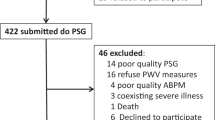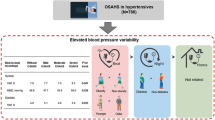Abstract
Overnight increases in arterial stiffness associated with sleep-disordered breathing may adversely affect patients with acute heart failure. Thus, we investigated overnight changes in arterial stiffness and their association with sleep-disordered breathing in patients hospitalized for acute heart failure. Consecutive patients with acute heart failure were enrolled. All participants underwent overnight full polysomnography following the initial improvement of acute signs and symptoms of acute heart failure. The arterial stiffness parameter, cardio-ankle vascular index (CAVI), was assessed before and after polysomnography. Overall, 60 patients (86.7% men) were analyzed. CAVI significantly increased overnight (from 8.4 ± 1.6 at night to 9.1 ± 1.7 in the morning, P < 0.001) in addition to systolic and diastolic blood pressure (from 114.1 mmHg to 121.6 mmHg, P < 0.001; and from 70.1 mmHg to 78.2 mmHg, P < 0.001, respectively). Overnight increase in CAVI (ΔCAVI ≥ 0) was observed in 42 patients (70%). The ΔCAVI ≥ 0 group was likely to have moderate-to-severe sleep-disordered breathing (i.e., apnea-hypopnea index ≥15, 55.6% vs 80.9%, P = 0.047) and greater obstructive respiratory events (29.4% vs 58.5%, P = 0.041). In multivariable analysis, moderate-to-severe sleep-disordered breathing and greater obstructive respiratory events were independently correlated with an overnight increase in CAVI (P = 0.033 and P = 0.042, respectively). In patients hospitalized for acute heart failure, arterial stiffness, as assessed by CAVI, significantly increased overnight. Moderate-to-severe sleep-disordered breathing and obstructive respiratory events may play an important role in the overnight increase in cardio-ankle vascular index.

This is a preview of subscription content, access via your institution
Access options
Subscribe to this journal
Receive 12 print issues and online access
$259.00 per year
only $21.58 per issue
Buy this article
- Purchase on Springer Link
- Instant access to full article PDF
Prices may be subject to local taxes which are calculated during checkout


Similar content being viewed by others
References
McDonagh TA, Metra M, Adamo M, Gardner RS, Baumbach A, Böhm M, et al. 2021 ESC guidelines for the diagnosis and treatment of acute and chronic heart failure. Eur Heart J. 2021;42:3599–726.
Kasai T, Floras JS, Bradley TD. Sleep apnea and cardiovascular disease: a bidirectional relationship. Circulation. 2012;126:1495–510.
Floras JS. Sleep apnea and cardiovascular risk. J Cardiol. 2014;63:3–8.
Linz D, Woehrle H, Bitter T, Fox H, Cowie MR, Bohm M, et al. The importance of sleep-disordered breathing in cardiovascular disease. Clin Res Cardiol. 2015;104:705–18.
Ishiwata S, Kasai T, Sato A, Suda S, Matsumoto H, Shitara J, et al. Prognostic effect of sleep-disordered breathing on hospitalized patients following acute heart failure. Clin Res Cardiol. 2022;111:663–72.
Kasai T, Yumino D, Redolfi S, Su MC, Ruttanaumpawan P, Mak S, et al. Overnight effects of obstructive sleep apnea and its treatment on stroke volume in patients with heart failure. Can J Cardiol. 2015;31:832–8.
Matsushita M, Shirakabe A, Hata N, Shinada T, Kobayashi N, Tomita K, et al. Association between the admission time and the clinical findings in patients with acute heart failure. J Cardiol. 2013;61:210–5.
Sakane K, Miyoshi T, Doi M, Hirohata S, Kaji Y, Kamikawa S, et al. Association of new arterial stiffness parameter, the cardio-ankle vascular index, with left ventricular diastolic function. J Atheroscler Thromb. 2008;15:261–8.
Miyoshi T, Doi M, Hirohata S, Sakane K, Kamikawa S, Kitawaki T, et al. Cardio-ankle vascular index is independently associated with the severity of coronary atherosclerosis and left ventricular function in patients with ischemic heart disease. J Atheroscler Thromb. 2010;17:249–58.
Zhang C, Ohira M, Iizuka T, Mikamo H, Nakagami T, Suzuki M, et al. Cardio-ankle vascular index relates to left ventricular ejection fraction in patients with heart failure. A retrospective study. Int heart J. 2013;54:216–21.
Saiki A, Ohira M, Yamaguchi T, Nagayama D, Shimizu N, Shirai K, et al. New horizons of arterial stiffness developed using cardio-ankle vascular index (CAVI). J Atheroscler Thromb. 2020;27:732–48.
Kumagai T, Kasai T, Kato M, Naito R, Maeno K, Kasagi S, et al. Establishment of the cardio-ankle vascular index in patients with obstructive sleep apnea. Chest. 2009;136:779–86.
Shirai K, Utino J, Otsuka K, Takata M. A novel blood pressure-independent arterial wall stiffness parameter; cardio-ankle vascular index (CAVI). J Atheroscler Thromb. 2006;13:101–7.
Budoff MJ, Alpert B, Chirinos JA, Fernhall B, Hamburg N, Kario K, et al. Clinical applications measuring arterial stiffness: an expert consensus for the application of cardio-ankle vascular index. Am J Hypertens. 2022;35:441–53.
McKee PA, Castelli WP, McNamara PM, Kannel WB. The natural history of congestive heart failure: the Framingham study. N Engl J Med. 1971;285:1441–6.
Suda S, Kasai T, Matsumoto H, Shiroshita N, Kato M, Kawana F, et al. Prevalence and clinical correlates of sleep-disordered breathing in patients hospitalized with acute decompensated heart failure. Can J Cardiol. 2018;34:784–90.
Berry RB, Brooks R, Gamaldo CE, Harding SM, Lloyd RM, Marcus CL and Vaughn BV for the American Academy of Sleep Medicine. The AASM Manual for the Scoring of Sleep and Associated Events: Rules, Terminology and Technical Specifications, Version 2.2. www.aasmnet.org. Darien, Illinois: American Academy of Sleep Medicine, 2015.
Nagueh SF, Abraham TP, Aurigemma GP, Bax JJ, Beladan C, Browning A, et al. Interobserver variability in applying American Society of Echocardiography/European Association of Cardiovascular Imaging 2016 guidelines for estimation of left ventricular filling pressure. Circ Cardiovasc Imaging. 2019;12:e008122.
Matsuo S, Imai E, Horio M, Yasuda Y, Tomita K, Nitta K, et al. Revised equations for estimated GFR from serum creatinine in Japan. Am J Kidney Dis. 2009;53:982–92.
Routledge FS, McFetridge-Durdle JA, Dean CR. Night-time blood pressure patterns and target organ damage: a review. Can J Cardiol. 2007;23:132–8.
Suzuki M, Guilleminault C, Otsuka K, Shiomi T. Blood pressure “dipping” and “non-dipping” in obstructive sleep apnea syndrome patients. Sleep. 1996;19:382–7.
Frigy A, Varga I, Fogarasi Z, Belényi B, Kocsis I. The influence of sleep apnea on 24-hour and nocturnal ECG and blood pressure parameters in patients with acute heart failure. Med Princ Pract. 2019;28:150–7.
Tomita Y, Kasai T. Relationship between cardio-ankle vascular index and obstructive sleep apnea. Rev Cardiovasc Med. 2020;21:353–63.
Horinaka S, Yagi H, Ishimura K, Fukushima H, Shibata Y, Sugawara R, et al. Cardio-ankle vascular index (CAVI) correlates with aortic stiffness in the thoracic aorta using ECG-gated multi-detector row computed tomography. Atherosclerosis. 2014;235:239–45.
Namba T, Masaki N, Matsuo Y, Sato A, Kimura T, Horii S, et al. Arterial stiffness is significantly associated with left ventricular diastolic dysfunction in patients with cardiovascular disease. Int Heart J. 2016;57:729–35.
Tomiyama H, Yamashina A. Non-invasive vascular function tests: their pathophysiological background and clinical application. Circ J. 2010;74:24–33.
Safar ME, Levy BI, Struijker-Boudier H. Current perspectives on arterial stiffness and pulse pressure in hypertension and cardiovascular diseases. Circulation. 2003;107:2864–9.
Zieman SJ, Melenovsky V, Kass DA. Mechanisms, pathophysiology, and therapy of arterial stiffness. Arterioscler Thromb Vasc Biol. 2005;25:932–43.
Kato M, Kumagai T, Naito R, Maeno K, Kasagi S, Kawana F, et al. Change in cardio-ankle vascular index by long-term continuous positive airway pressure therapy for obstructive sleep apnea. J Cardiol. 2011;58:74–82.
Bradley TD, Tkacova R, Hall MJ, Ando S, Floras JS. Augmented sympathetic neural response to simulated obstructive apnoea in human heart failure. Clin Sci. 2003;104:231–8.
Narkiewicz K, Kato M, Phillips BG, Pesek CA, Davison DE, Somers VK. Nocturnal continuous positive airway pressure decreases daytime sympathetic traffic in obstructive sleep apnea. Circulation. 1999;100:2332–5.
Kuramoto E, Kinami S, Ishida Y, Shiotani H, Nishimura Y. Continuous positive nasal airway pressure decreases levels of serum amyloid A and improves autonomic function in obstructive sleep apnea syndrome. Int J Cardiol. 2009;135:338–45.
Shiina K, Tomiyama H, Takata Y, Yoshida M, Kato K, Saruhara H, et al. Effects of CPAP therapy on the sympathovagal balance and arterial stiffness in obstructive sleep apnea. Respir Med. 2010;104:911–6.
Bradley TD, Hall MJ, Ando S, Floras JS. Hemodynamic effects of simulated obstructive apneas in humans with and without heart failure. Chest. 2001;119:1827–35.
Kasai T, Bradley TD. Obstructive sleep apnea and heart failure: pathophysiologic and therapeutic implications. J Am Coll Cardiol. 2011;57:119–27.
Somers VK, Dyken ME, Skinner JL. Autonomic and hemodynamic responses and interactions during the Mueller maneuver in humans. J Auton Nerv Syst. 1993;44:253–9.
Mansfield D, Kaye DM, Brunner La Rocca H, Solin P, Esler MD, Naughton MT. Raised sympathetic nerve activity in heart failure and central sleep apnea is due to heart failure severity. Circulation. 2003;107:1396–400.
Spaak J, Egri ZJ, Kubo T, Yu E, Ando S, Kaneko Y, et al. Muscle sympathetic nerve activity during wakefulness in heart failure patients with and without sleep apnea. Hypertension. 2005;46:1327–32.
Minatoguchi S, Ito H, Ishimura K, Watanabe H, Imai Y, Koshiji M, et al. Modulation of noradrenaline release through presynaptic alpha 2-adrenoceptors in congestive heart failure. Am Heart J. 1995;130:516–21.
Minatoguchi S. Heart failure and its treatment from the perspective of sympathetic nerve activity. J Cardiol. 2022;79:691–7.
Yumino D, Redolfi S, Ruttanaumpawan P, Su MC, Smith S, Newton GE, et al. Nocturnal rostral fluid shift: a unifying concept for the pathogenesis of obstructive and central sleep apnea in men with heart failure. Circulation. 2010;121:1598–605.
Miyashita Y, Saiki A, Endo K, Ban N, Yamaguchi T, Kawana H, et al. Effects of olmesartan, an angiotensin II receptor blocker, and amlodipine, a calcium channel blocker, on cardio-ankle vascular index (CAVI) in type 2 diabetic patients with hypertension. J Atheroscler Thromb. 2009;16:621–6.
Noike H, Nakamura K, Sugiyama Y, Iizuka T, Shimizu K, Takahashi M, et al. Changes in cardio-ankle vascular index in smoking cessation. J Atheroscler Thromb. 2010;17:517–25.
Shirai K, Song M, Suzuki J, Kurosu T, Oyama T, Nagayama D, et al. Contradictory effects of β1- and α1- aderenergic receptor blockers on cardio-ankle vascular stiffness index (CAVI)–CAVI independent of blood pressure. J Atheroscler Thromb. 2011;18:49–55.
Dikmenoğlu N, Ciftçi B, Ileri E, Güven SF, Seringeç N, Aksoy Y, et al. Erythrocyte deformability, plasma viscosity and oxidative status in patients with severe obstructive sleep apnea syndrome. Sleep Med. 2006;7:255–61.
Kim T, Lee CS, Lee SD, et al. Impacts of comorbidities on the association between arterial stiffness and obstructive sleep apnea in the elderly. Respiration. 2015;89:304–11.
Kumagai T, Kasai T, Kato M, et al. Establishment of the cardio-ankle vascular index in patients with obstructive sleep apnea. Chest. 2009;136:779–86.
Acknowledgements
The authors are grateful to the staff of all the facilities included in this study.
Funding
This study was partially supported by a Grant-in-Aid for Scientific Research (Grant Number: 26507010); JSPS KAKENHI (Grant Numbers: JP17K09527, JP18K15904, JP21K08116, JP21K16033, JP21K16034); a grant to The Intractable Respiratory Diseases and Pulmonary Hypertension Research Group from the Ministry of Health, Labor and Welfare, Japan (Grant/Award Number: 20FC1027); and a research grant from the Japanese Center for Research on Women in Sport, Juntendo University. These funding sources did not play any other role in this study.
Author information
Authors and Affiliations
Corresponding author
Ethics declarations
Conflict of interest
TK, RN, MK, and FK are affiliated with departments endowed by Philips Respironics, ResMed, and Fukuda Denshi. Dr. TK and NS are affiliated with a department endowed by Paramount Bed.
Additional information
Publisher’s note Springer Nature remains neutral with regard to jurisdictional claims in published maps and institutional affiliations.
Rights and permissions
Springer Nature or its licensor (e.g. a society or other partner) holds exclusive rights to this article under a publishing agreement with the author(s) or other rightsholder(s); author self-archiving of the accepted manuscript version of this article is solely governed by the terms of such publishing agreement and applicable law.
About this article
Cite this article
Yatsu, S., Kasai, T., Naito, R. et al. Impact of sleep-disordered breathing on overnight changes in arterial stiffness in patients with acute heart failure. Hypertens Res 47, 342–351 (2024). https://doi.org/10.1038/s41440-023-01448-y
Received:
Revised:
Accepted:
Published:
Issue Date:
DOI: https://doi.org/10.1038/s41440-023-01448-y
Keywords
This article is cited by
-
Intriguing review and topics in this month of Hypertension Research
Hypertension Research (2024)



